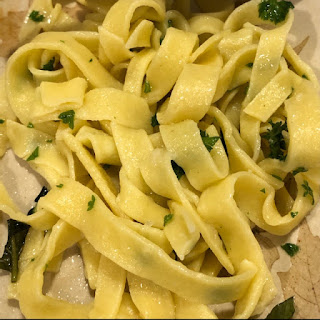ATK Pasta without a pasta maker
Based on the recipe from America's Test Kitchen (subscription needed)
NOTES
1. Makes about a pound of pasta; serves 4 with full servings.
2. Pasta is very plain and can be seasoned with fresh herbs, herb butter, vegetables, etc.
3. Recipe can very easily be halved. Amounts are in parentheses.
4. Uses a food processor, making this recipe very easy and satisfying.
5. If using high protein flour (e.g. King Arthur Baking), increase the egg yolks by one.
6. Be sure the eggs are cold so they will be easier to separate. Plan what you want to use the egg whites for and reserve them in the fridge.
7. The longer the dough rests when rolled into a cylinder, up to 4 hours, the easier it will be to roll out.
8. Use a very light touch when sprinkling flour on the dough.
9. Be sure you have at least 24" of space to roll out pieces of the dough.
10. Fresh noodles should be cooked within 1 hour. Otherwise, the prepared noodles can be placed in a ziplock bag, frozen, and stored for around 2 weeks. Frozen noodles can be tossed into boiling water without thawing.
INGREDIENTS (half amounts in parentheses)
2 cups/10 oz all purpose flour (1 cup/5 oz)
2 large eggs (1 egg)
6 egg yolks (3 yolks)
2 Tbl olive oil (1 Tbl)
PREPARATION
1. In a food processor, combine the flour, oil, eggs, and yolks for about 45 seconds until the mixture forms a cohesive dough that feels soft and barely tacky.
- If dough sticks to your fingers, add flour a tablespoon at a time, until barely tacky, up to 4 Tbl (2 Tbl)
- If dough doesn't come together, add water a teaspoon at a time, up to 3 tsps (1-1/2 tsp), until it just comes together, then process 30 seconds longer.
2. Turn dough ball out onto dry surface and knead 1-2 minutes until smooth.
3. Shape dough into a 6-inch-long cylinder and wrap in plastic so it doesn't dry out. Set aside at room temperature to rest for at least 1 hour and up to 4 hours.
4. After resting, have some loose flour ready and cut cylinder crosswise into 6 equal pieces (3 pieces).
5. Pull out one piece and leave others under plastic wrap to prevent it from drying out.
6. Place the piece of dough on the counter and gently press it into a roughly 3" x 3" square; lightly dust both sides of the dough with flour.
7. Using a heavy rolling pin, roll into a 6" square and lightly dust both sides.
8. With a rolling pin and starting at the center of the square, roll dough away from you in one motion; then return the rolling pin to the center and roll toward you in one motion.
9. Repeat steps of rolling until dough sticks to counter and measures 12" long and lightly dust both sides again. Try to keep width around 6"
10. As you continue rolling dough, occasionally lift the dough to release it from the counter; roll until it measures roughly 20" long and 6" wide. You should be able to see the outline of your fingers through the dough.
- If dough firmly sticks to counter and/or wrinkles when rolled out, dust the dough lightly.
11. Transfer rolled out pasta sheet onto a dry kitchen towel and leave uncovered for about 15 minutes as you continue rolling out remaining pieces of dough. (After 15 minutes, the edges of the rolled pasta should be firm.)
12. When all pieces are rolled into sheets and have dried edges, take one sheet at a time, start at its narrow end, and gently fold it at 2" intervals until the sheet has been folded into a flat, loose rectangular roll. Repeat folding and cutting with remaining pasta dough.
13. Prepare a rimmed baking sheet or large cutting board with parchment paper. With a sharp chef's knife, slice crosswise into uniformly thin strips, about 1/8"-1/4" wide; unfurl the pasta carefully and place the noodles onto the prepared baking sheet/cutting board.
14. When ready to cook the noodles, add about a Tbl of salt to a pot of water and bring to a boil.
15. Add pasta and cook until tender, about 3 minutes.
- If planning to add herbs, vegetables, etc., reserve about a cup of pasta water before draining the pasta. After draining, add noodles and other items back to pot, add some pasta water, and heat briefly until liquid evaporates.


Comments